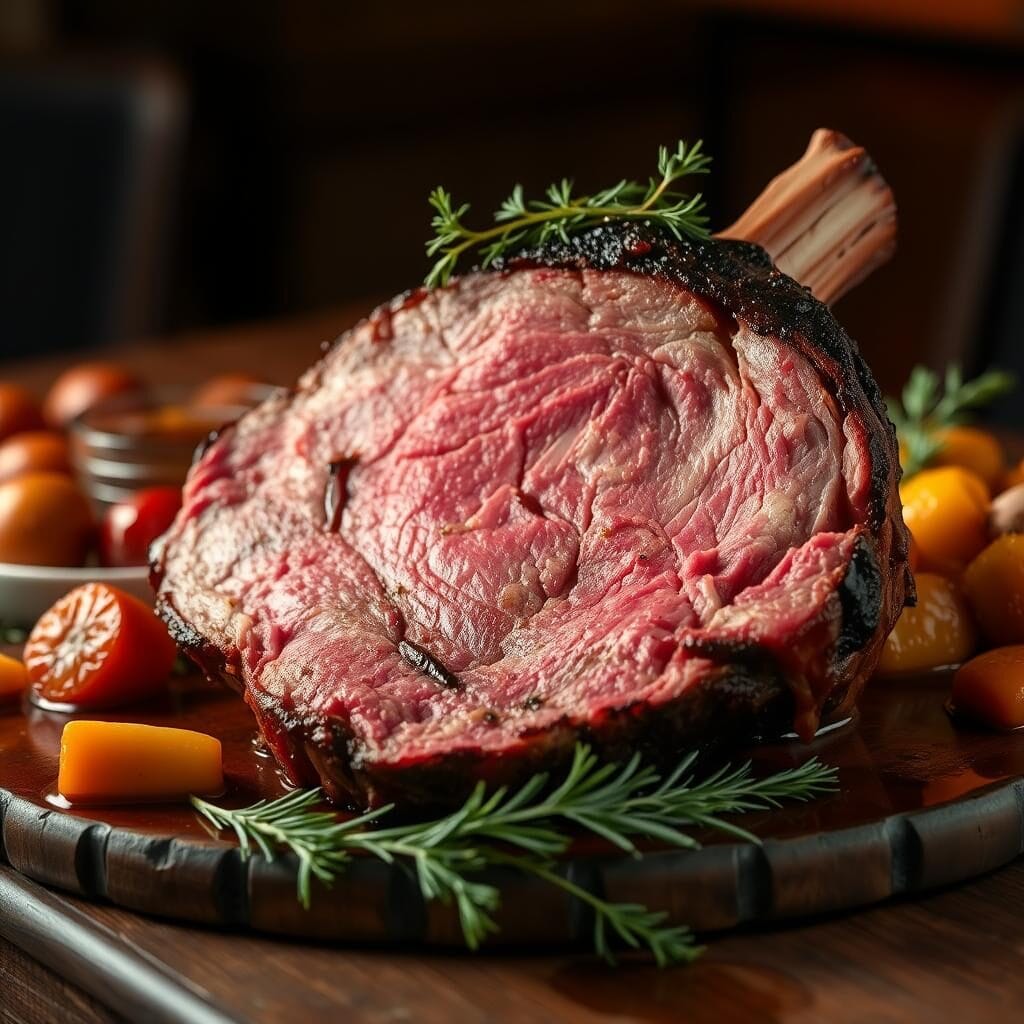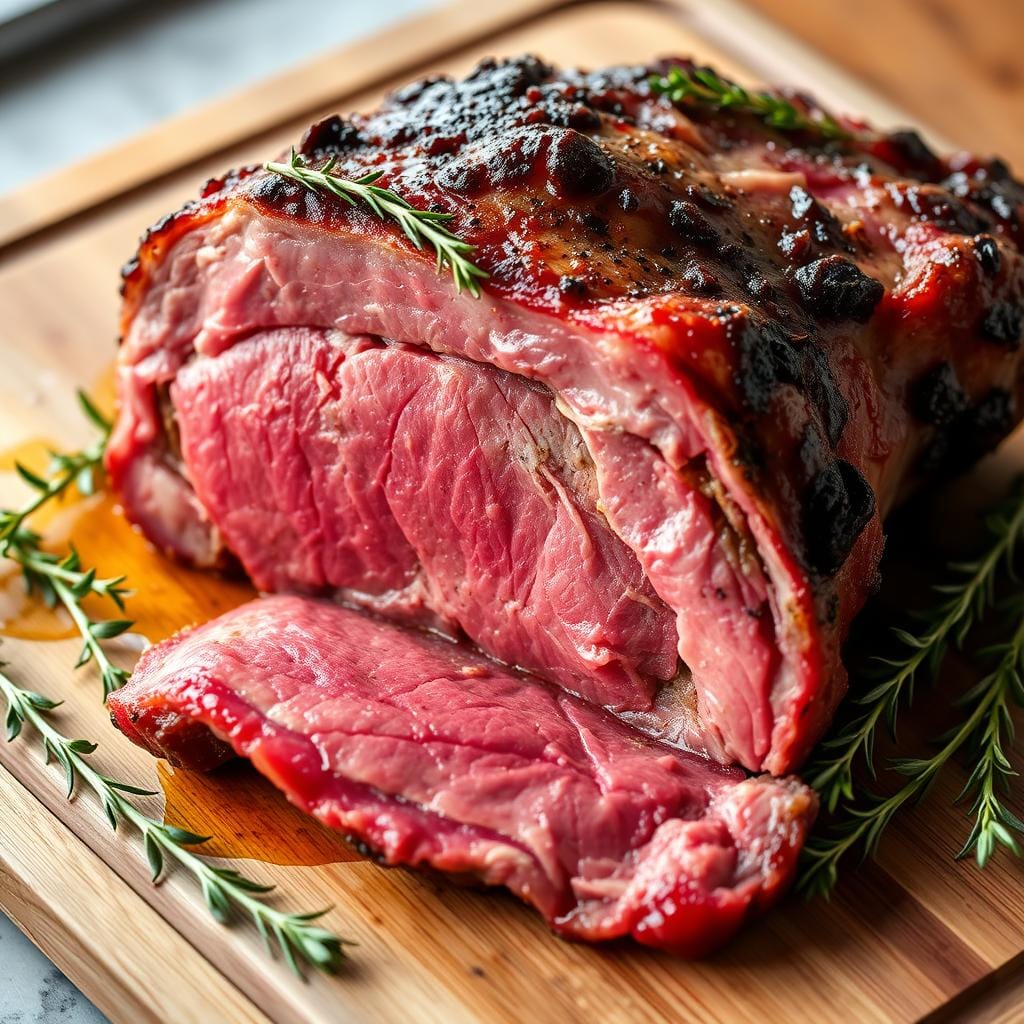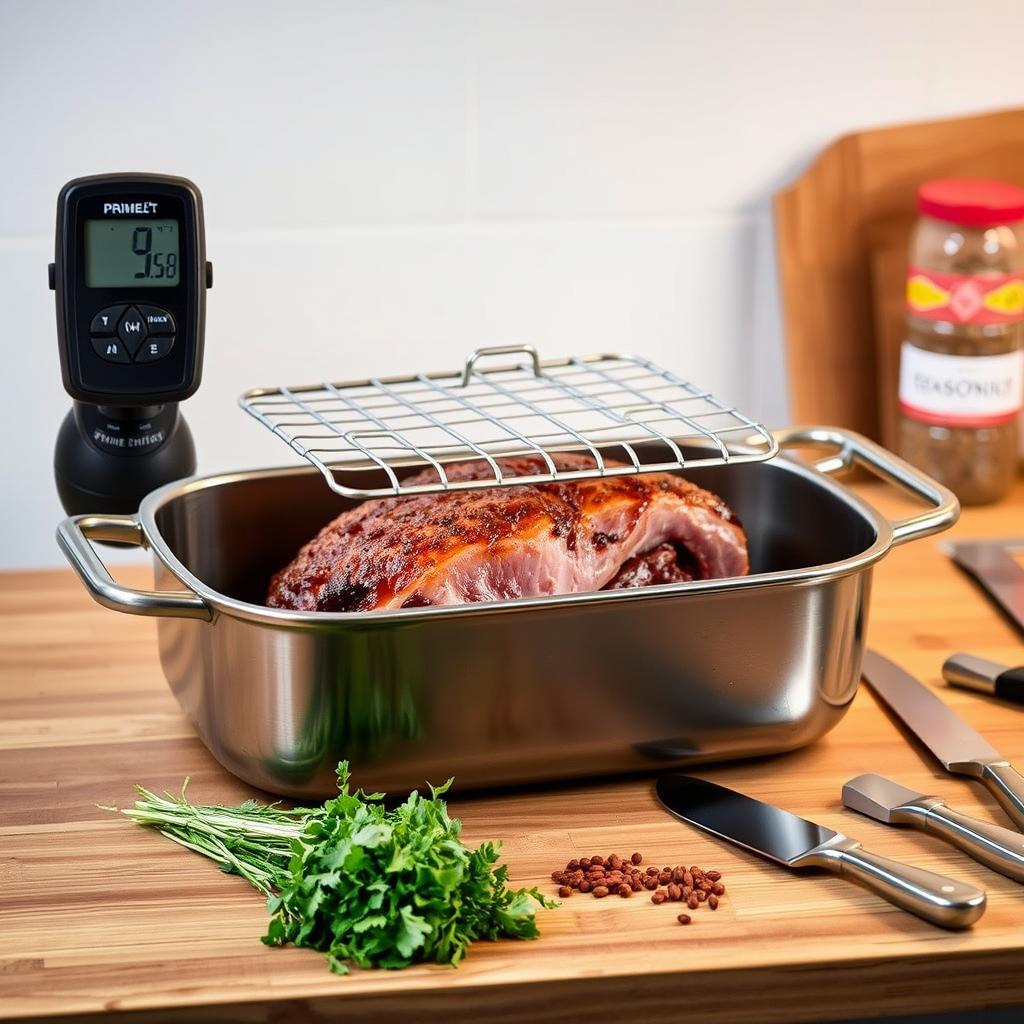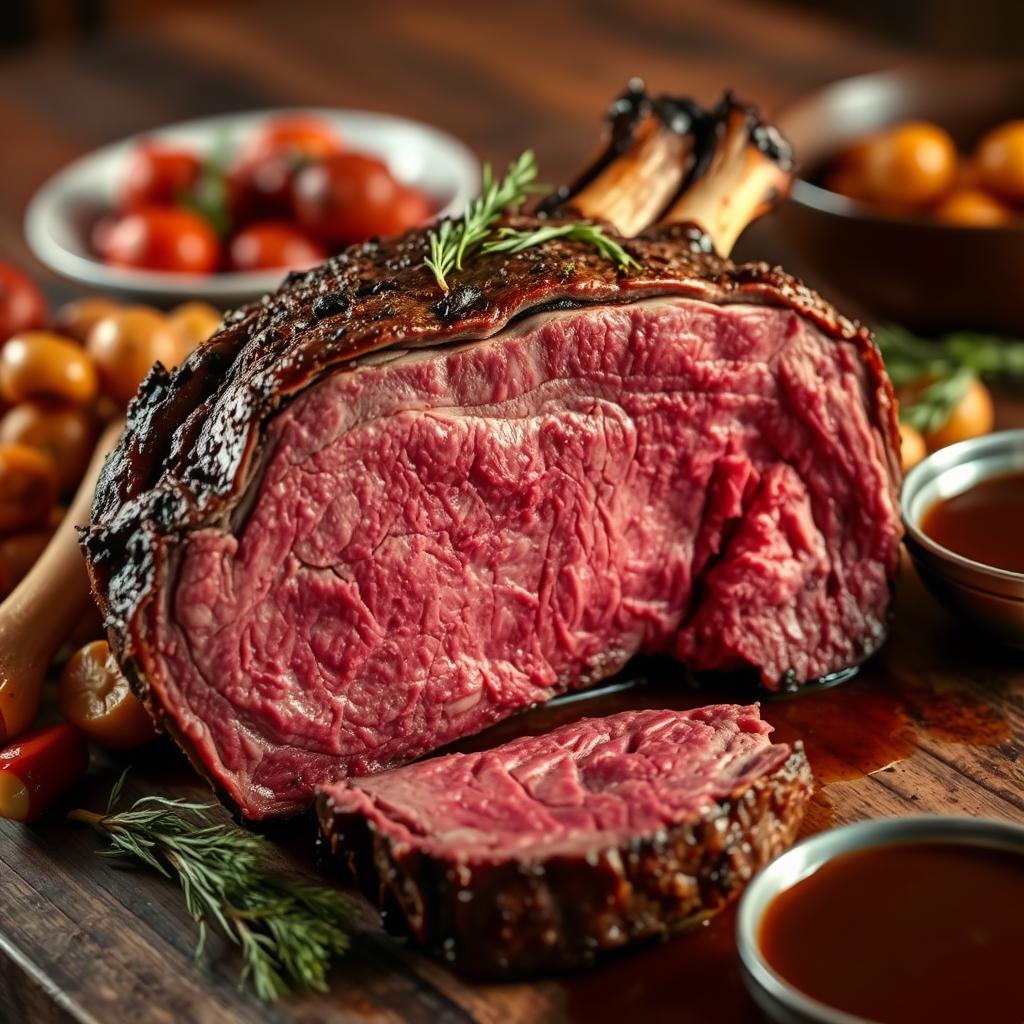How long does it take for a prime rib roast? Standing before the shining, ruby-red roast, the rich aroma fills the air. You’re eager to host a special occasion or bring loved ones together for a lavish meal. The prime rib, a symbol of indulgence and culinary mastery, is the centerpiece of it all.
But, there’s a delicate balance of time, temperature, and technique. These are the keys to unlocking the true essence of this coveted cut of meat.
How Long Does It Take For A Prime Rib Roast?
The question on every home cook’s mind is, “How long does it take to roast the perfect prime rib?” The answer is not simple. It’s a harmonious symphony of factors that need precision.
In this article, we’ll explore the intricacies of prime rib. We’ll understand its unique qualities and master the art of roasting it to perfection.

Key Takeaways
- Discover the secrets that make prime rib a truly special and indulgent cut of meat.
- Learn how to identify the different grades of prime rib and why they matter.
- Understand the essential equipment and techniques required for perfect prime rib roasting.
- Uncover the optimal cooking times and temperature guidelines for achieving your desired level of doneness.
- Explore the best seasoning methods and resting techniques to elevate your prime rib to new heights.
Understanding Prime Rib: What Makes It Special
Prime rib is a favorite cut of beef known for its high quality and delicious taste. It comes from the rib section, famous for its marbling and tender texture. To fully enjoy prime rib, it’s key to know what makes it so special.
Different Grades of Prime Rib
The USDA grading system is key in determining prime rib quality. The top grade, USDA Prime, is for the most marbled and flavorful cuts. These cuts are highly sought after by chefs and food lovers. USDA Choice is also great, offering a mix of tenderness and flavor. Knowing the grading system helps you choose the best prime rib for your dishes.
Anatomy of a Prime Rib Cut
The prime rib cut is between the 6th and 12th ribs of the beef. This location makes it perfect for roasting. The muscles in this area are well-exercised, leading to a tender and juicy prime rib.
Why Prime Rib Is Worth the Investment
Prime rib might cost more than other beef cuts, but it’s worth it. Its natural marbling and tender texture offer a luxurious dining experience. Plus, its size and versatility make it ideal for special events or impressing guests.

Essential Equipment for Perfect Prime Rib Roasting
Roasting a prime rib needs the right tools for the perfect result. You’ll need a sturdy roasting pan and an accurate meat thermometer. The right equipment makes a big difference.
A high-quality roasting pan is key. Choose one with a V-shaped rack to catch juices. This keeps the meat moist and tender. Look for a pan made of heavy-duty materials like stainless steel or cast iron. They distribute heat well and prevent hot spots.
A reliable meat thermometer is also crucial. A digital probe-style thermometer lets you check the prime rib’s internal temperature accurately. Remember, the meat will keep cooking after it’s out of the oven.
| Prime Rib Roasting Equipment | Importance |
|---|---|
| Roasting Pan | Allows for even heat distribution and juices collection |
| Meat Thermometer | Ensures accurate monitoring of internal temperature |
| Basting Brush | Helps lock in moisture and enhance flavor |
| Carving Knife and Fork | Enables precise, elegant slicing of the roast |
With the right equipment, you’ll make a delicious, restaurant-quality prime rib. It will impress your guests and satisfy your cravings.

Preparing Your Prime Rib for Roasting
Before you can enjoy a perfectly cooked prime rib, there are a few steps to take. Trimming, temperature control, and seasoning are key to great results.
Proper Trimming Techniques
Trimming your prime rib roast is crucial. Start by removing excess fat or silver skin. This helps seasoning penetrate and ensures even cooking. Use a sharp knife to trim, being careful not to remove too much fat.
Room Temperature Guidelines
Bring your prime rib to room temperature before roasting. This makes it cook more evenly, resulting in a juicier and more flavorful dish. Remove the roast from the fridge 1-2 hours before cooking, depending on its size.
Seasoning Methods and Timing
There are many seasoning options for your prime rib. A simple salt and pepper rub works well, or you can try more complex blends. Season evenly over the roast, massaging it into the meat for better flavor. Season at least 30 minutes before roasting, or up to 24 hours in advance for deeper flavor.
How Long Does It Take For A Prime Rib Roast?
Roasting a prime rib is all about timing. The cooking time depends on the roast’s weight and how rare you like it. Knowing the right prime rib cooking time is key to a delicious, juicy prime rib.
For a rare to medium-rare prime rib, cook it for about 15 to 20 minutes per pound. A 4-pound roast will need 60 to 80 minutes. But remember, the prime rib doneness also depends on the oven temperature and how accurate your meat thermometer is.
| Roast Weight | Rare (120-125°F) | Medium-Rare (130-135°F) | Medium (140-145°F) |
|---|---|---|---|
| 4 lbs | 60-70 min | 70-80 min | 80-90 min |
| 6 lbs | 90-105 min | 105-120 min | 120-135 min |
| 8 lbs | 120-140 min | 140-160 min | 160-180 min |
These times are just a guide. Your actual prime rib cooking time might be different. It depends on your oven, the roast’s size and shape, and how rare you prefer it. Always use a meat thermometer to check the temperature.
By knowing the right prime rib cooking time and checking the temperature, you can make a prime rib that will wow everyone.
Temperature Guidelines for Different Levels of Doneness
Getting the perfect doneness for your prime rib roast is key to a great meal. Each temperature range gives a unique texture and taste. Knowing the right prime rib temperature for your prime rib doneness is crucial.
Rare to Well-Done Temperature Chart
| Doneness Level | Internal Temperature (°F) |
|---|---|
| Rare | 120-125°F |
| Medium-Rare | 130-135°F |
| Medium | 140-145°F |
| Medium-Well | 150-155°F |
| Well-Done | 160°F and above |
Using Meat Thermometers Correctly
To get the perfect prime rib temperature, use a good meat thermometer. Stick it into the thickest part of the roast, avoiding bones. Check the temperature often to avoid overcooking.
Temperature Carry-Over Effect
Remember the temperature carry-over effect. The roast’s temperature will rise after it’s out of the oven. So, take it out when it’s a few degrees shy of your desired prime rib temperature.
Best Seasoning Techniques for Prime Rib
Turning a prime rib roast into a masterpiece is an art. It can make your meal unforgettable. We’ll look at the top ways to season your prime rib, from herb rubs to marinades.
Dry Rubs: The Foundation of Flavor
A good dry rub is key to a tasty prime rib. Mix salt, pepper, and spices like garlic powder and smoked paprika. Rub it all over the meat to get a flavorful crust.
Herb Crusts: Elevating the Aroma
Try a fresh herb crust for a unique flavor. Mix minced herbs with breadcrumbs, Parmesan, and olive oil. This creates a savory layer that enhances the meat’s taste.
Marinades: Infusing Moisture and Flavor
Marinating adds juiciness and flavor to your prime rib. Use red wine, garlic, and herbs for a tasty marinade. Let it soak for a few hours or overnight for the best results.
| Seasoning Technique | Ingredients | Benefits |
|---|---|---|
| Dry Rub |
| Creates a flavorful crust and caramelized exterior |
| Herb Crust |
| Adds aromatic depth and a crispy texture |
| Marinade |
| Infuses moisture and robust flavors |
Choose from dry rubs, herb crusts, or marinades to enhance your prime rib. Let the meat’s natural flavor be the star. Experiment to find your favorite way to season and enjoy a memorable meal.
Resting Time: Why It’s Crucial for Perfect Results
Preparing a mouthwatering prime rib roast requires a crucial step: resting. After taking it out of the oven, letting it rest is key. This step ensures the meat stays juicy and tender, making it truly special.
How Long to Rest Your Roast
The resting time for a prime rib roast is between 15 to 30 minutes. This pause lets the juices spread evenly, making the meat more flavorful. Resting your prime rib for the right amount of time guarantees a juicy prime rib that’s perfectly cooked.
Proper Resting Techniques
- Remove the roast from the oven and place it on a cutting board or serving platter.
- Loosely cover the roast with aluminum foil to retain heat and moisture.
- Allow the roast to rest undisturbed for 15 to 30 minutes, depending on the size of the cut.
- Use this time to prepare any accompanying sauces or side dishes.
Resting your prime rib roast is essential. It ensures the prime rib resting time is used well. This results in a succulent and flavorful dish that will wow your guests.
“Allowing your prime rib to rest is the secret to achieving that perfect balance of juiciness and tenderness.”
Common Prime Rib Roasting Mistakes to Avoid
Cooking the perfect prime rib roast needs precision and care. Many home cooks make prime rib cooking errors that can cause overcooking prime rib or other prime rib troubleshooting issues. To make sure your prime rib is tender, juicy, and full of flavor, avoid these common mistakes.
One big mistake is overcooking the prime rib. People often follow old guidelines or wrong cooking times, making the roast dry and tough. To prevent this, use a meat thermometer and check the internal temperature often. Take the roast out of the oven when it’s cooked to your liking.
- Not seasoning the prime rib well can make it taste bland. Make sure to season it with coarse salt, black pepper, and other herbs or spices. Let it sit at room temperature for at least 30 minutes before roasting.
- Not letting the prime rib rest is another mistake. After taking it out of the oven, let it rest for 15-20 minutes before slicing. This helps the juices spread evenly, making the meat moist and flavorful.
- Choosing the wrong cut of prime rib can also ruin the dish. Go for the ribeye cap (also known as the “deckle”) for better flavor and tenderness. Avoid the leaner, tougher chuck end.
Avoiding these prime rib roasting mistakes can make your next prime rib dish amazing. You’ll impress your guests with a truly exceptional meal.
“The key to a perfect prime rib is mastering the cooking technique and avoiding common pitfalls. With the right approach, you can create a showstopping roast that will have your guests raving.”
Carving and Serving Your Prime Rib
The final step in your prime rib journey is carving and serving. Mastering the art of slicing and presenting your perfectly cooked prime rib roast will ensure a memorable dining experience for your guests. Let’s explore the essential tools and techniques to make your prime rib the star of the show.
Essential Carving Tools
To carve your prime rib with precision, you’ll need a few key tools:
- A sharp, long-bladed carving knife: This will allow you to make clean, even slices through the tender meat.
- A carving fork: This sturdy fork helps you hold the roast in place while you slice.
- A meat slicer or electric knife (optional): For effortless, uniform slices.
Having the right tools on hand will make the carving process a breeze and ensure your prime rib is presented beautifully.
Step-by-Step Carving Guide
Follow these simple steps to carve your prime rib like a pro:
- Allow the roast to rest for at least 15-20 minutes after removing it from the oven. This will ensure the juices have had a chance to redistribute throughout the meat.
- Position the roast on a sturdy cutting board or carving station, with the fatty side facing up.
- Using your carving knife, slice the prime rib across the grain in smooth, even strokes. Aim for slices about 1/2 to 1 inch thick.
- Transfer the slices to a warmed serving platter, arranging them in an overlapping pattern for a visually appealing presentation.
- Serve the prime rib immediately, accompanied by your favorite sides and sauces, such as horseradish or au jus.
With a little practice, you’ll be carving and serving your prime rib like a true culinary expert.
Conclusion
In this article, you’ve learned a lot about making the perfect prime rib roast. You now know about the different grades and how to choose the right cut. You also know the essential tools and techniques to make your prime rib recipe stand out as a holiday meal centerpiece.
Getting great results comes from paying attention to cooking time, temperature, and resting. By using the tips from this guide, you’ll make a prime rib that’s juicy, tender, and full of flavor.
The perfect prime rib roast is more than just food; it’s a highlight of any gathering. Use what you’ve learned to impress your family and friends. You’ll get praise and the joy of serving an amazing dish.

